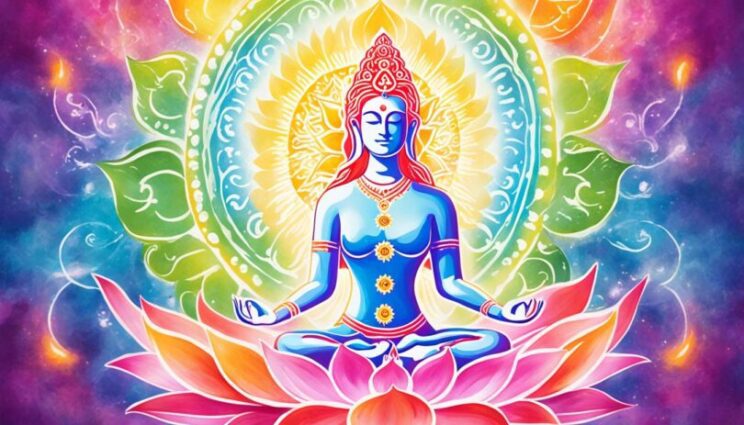Kriya Yoga is more than just exercise; it’s a full path for deep spiritual growth through meditation. By meditating in this way, people reach a deep inner peace and connect their awareness with the Divine. Kriya Yoga includes more than physical poses. It covers asana, pranayama, and other practices, too. This holistic approach leads to happiness and a feeling of complete spiritual accomplishment.
Many who practice Kriya Yoga notice big improvements in their mental and emotional health. They find inner peace. Also, many say they can think better and get more done at work. Creating a habit of regular meditation also helps people have happier family lives.
It’s clear that adding Kriya Yoga to your life can decrease stress. It can even make you healthier and more energetic. For some, it’s a step toward a constantly joyful connection with the Divine. This journey includes self-control, learning about oneself, and giving up old habits, as taught by Patanjali’s Yoga Sutras.
Key Takeaways
- High percentage of practitioners experience immediate inner peace.
- Improved concentration and efficiency at work due to meditation.
- Enhanced harmony and joy in relationships and family life.
- Significant reduction in stress levels after incorporating meditation.
- Notable improvements in health and vitality for meditation practitioners.
- Pathway toward ultimate spiritual goals and union with the Divine.
Introduction to Kriya Yoga Meditation
Kriya Yoga Meditation is a powerful way to calm the mind and boost well-being. It merges the body, mind, and spirit, offering a complete health solution. It stands on the principles of yoga, bringing balance to one’s life.
Kriya Yoga, according to Paramahansa Yogananda, is a pathway to the Infinite. This technique focuses on inner peace and understanding our true nature. Engaging in Kriya Yoga leads to harmony within the body, mind, and spirit.
Yogananda highlights the role of divine joy in Kriya Yoga. Through its practices, one finds lasting happiness and purpose. The approach, taught by SRF gurus, helps in spiritual growth and self-discovery.
Revived in 1861 by Mahavatar Babaji, Kriya Yoga was spread by disciples like Lahiri Mahasaya. Its popularity grew thanks to Paramahansa Yogananda. Yogananda’s “Autobiography of a Yogi” indicates the fast spiritual growth it brings.
Preparation for Kriya initiation takes about a year of study and practice. Initiation events are held in many countries. You can learn Kriya in person at Ananda Centers, or online, with support always available.
Historical Background of Kriya Yoga
Kriya Yoga is a spiritual system with a deep history in ancient yogic practices. It has been around for thousands of years, aiming for spiritual awakening and a higher level of self-awareness. Through techniques like breath control and focusing inward, it carries the wisdom of ancient times.

Ancient Origins
Kriya Yoga’s roots go back thousands of years to ancient traditions. It was passed down in sacred texts and teachings by holy people seeking spiritual truth. Mahavatar Babaji, an immortal yogi, brought Kriya Yoga back to light after many years. The main idea is to link a person’s breath with the energy of the universe, leading to oneness and peace.
Modern Revival
Kriya Yoga saw a new birth in the 19th century, thanks to Mahavatar Babaji’s efforts. Lahiri Mahasaya was the first to teach it openly, changing it from a secret practice to something many could learn. This started a chain reaction. His students, including Swami Sri Yukteswar Giri, helped spread Kriya Yoga even more. Yukteswar Giri then trained Paramahansa Yogananda, who introduced it to the US and Europe through his Self-Realization Fellowship in 1920.
Today, Kriya Yoga has evolved from a hidden method to a well-known path for spiritual growth, thanks to modern yoga. Babaji believed Kriya Yoga could create unity among countries by bringing inner peace. This technique is known to help people reach high spiritual levels through focused breathing and meditation.
The Core Principles of Kriya Yoga
Kriya Yoga’s core principles come from Patanjali’s Yoga Sutras, 195 short sayings guiding practitioners to spiritual enlightenment. These teachings blend self-discipline, self-study, and surrender to the Divine.

Self-discipline
Self-discipline is key in Kriya Yoga. It’s called tapas in the Yoga Sutras. This principle encourages strict practices that cleanse the body and mind. It means committing to daily habits that support health and clear thinking. This leads to a life that’s mindful and intentional.
Self-study
In Kriya Yoga, svadhyaya is crucial, too. This means looking at your own experiences, thoughts, and actions. It involves reflecting and studying sacred texts. Self-study helps build deep understanding and a strong connection with your inner wisdom.
Surrender
Ishvara pranidhana, part of Kriya Yoga, is about surrender. It’s giving up ego and trusting a higher power. Practitioners find peace and clarity when they let go of control and put their faith in the divine plan.
Practiced by saints and sages, Kriya Yoga links breath with mind. Passed from teacher to student, it includes pillars of various types of Yoga. Following these principles leads to a path of calm, peace, happiness, and care for others.
| Principle | Description |
|---|---|
| Self-discipline | Promotes rigorous practices for purification and mindful living. |
| Self-study | Encourages reflective practices and the study of sacred texts. |
| Surrender | Involves trusting in the divine and dedicating actions to a higher power. |
Understanding the Eight Limbs of Yoga
The Eight Limbs of Yoga, found in the Patanjali Yoga Sutras, are a guide to living a balanced and fulfilling life. These limbs lead us towards greater states of meditation and understanding.

Yama and Niyama
Yama is the first limb. It teaches us moral values and how to act. Key parts include Ahimsa (nonviolence) and Satya (truth). Following these makes our practice stronger and more ethical.
Niyama is the second limb. It’s about self-discipline and spiritual habits. Saucha (cleanliness) and Isvara pranidhana (surrender) are part of this. These are the first steps in our yogic journey.
Asana and Pranayama
Asana, the third limb, is physical postures. They make our bodies strong and flexible, which helps in our spiritual growth.
Pranayama, the fourth limb, is breath control. It links breath with the mind and emotions. It prepares us for meditation.
Pratyahara and Dharana
Pratyahara, the fifth limb, is about turning our senses inward. We learn to ignore outside distractions. This prepares us for deeper practice.
Dharana, the sixth limb, is all about focus. It helps us overcome distractions and prepare for meditation.
Dhyana and Samadhi
Dhyana, the seventh limb, is deep meditation. It’s about focused contemplation. This kind of meditation raises our awareness levels.
Samadhi, the eighth limb, is the pinnacle. It marks the ultimate state of meditation. Here, we feel one with the Divine. This is the highest freedom and bliss in yoga.
The Role of Pranayama Breathing in Kriya Yoga
Pranayama is vital in Kriya Yoga. It helps users control and direct prana, or life energy. This leads to physical benefits such as boosting lung strength, better sleep, and removing toxins from the body.

Deep breathing in Kriya Yoga includes methods like Kapalbhati. It cleans the body. Practices like Mandukasana help the lower back and digestion. Yet, some pranayama are not safe for pregnant women, heart and epilepsy patients, those with high blood pressure, or kids under twelve.
Kriya Yoga also has breath techniques to increase vitality and control energy. The Pranic Energization Technique recharges the body. Nadi Shuddhi makes the mind peaceful and balances energy channels.
Methods like Dog breathing help the stomach and cleanse. Rabbit breathing is good for asthma. But avoid this if you have epilepsy or high blood pressure.
Kriya Yoga is seen as a scientific way to reach higher awareness. Paramahansa Yogananda said deep breathing in Kriya helps control life energy consciously. He called it a “scientific highway to the Infinite”, focusing on inner consciousness.
In conclusion, pranayama in Kriya Yoga has deep effects. It involves controlled breathing that supports spiritual growth and awareness.
Exploring Chakras and Energy Centers

Most yoga traditions recognize seven chakra energy centers, which are linked to different emotional and mental states. Kriya Yoga is dedicated to these chakras and focuses on aligning them through meditation, which is crucial for spiritual growth.
The Root Chakra is the first one, focusing on survival and feeling secure. Issues with this chakra can cause feelings of instability. A Kundalini Yoga class focusing on this chakra takes 54 minutes.
Next is the Sex Organs chakra, which is about pleasure and creativity. Kundalini Yoga offers a 7-minute meditation for this chakra. The Navel Point chakra deals with personal power and decision-making.
Moving up, the Heart Center chakra emphasizes love and empathy. The Throat Chakra, the fifth one, is about sound and self-expression.
The Third Eye Point chakra enhances intuition and insight. Lastly, the Crown Chakra is about pure thought and deep understanding.
| Chakra | Attributes | Kundalini Yoga Specifics |
|---|---|---|
| Root Chakra | Survival, feeling grounded | 54-minute class |
| Sex Organs Chakra | Pleasure, creativity, inspiration | 7-minute meditation |
| Navel Point Chakra | Personal power, decision-making | — |
| Heart Center Chakra | Love, compassion, interconnectedness | — |
| Throat Chakra | Sound, communication, creativity, expression | Located in the throat area |
| Third Eye Point Chakra | Intuition, visualization, perception | — |
| Crown Chakra | Thoughts, information, understanding | — |
Ancient cultures from Egypt to the Maya held the chakras in high regard. They believed spiritual leaders gained psychic powers by understanding these energy centers. People like Moses and Milarepa spent years learning these secrets.
Kriya Yoga today, taught by Nayaswami Savitri, uses meditations to awaken the chakras. She recommends reading “Chakras for Starters” by Savitri Simpson. This work shows the power of Kundalini and Kriya Yoga in raising our awareness and psychic abilities.
Mantra Chanting in Kriya Yoga Practice

Mantra chanting is key in Kriya Yoga, woven into the art of meditation and spiritual growth. It sharpens the mind and spreads energy within us. This power of mantra chanting can deeply reflect within the practitioner.
Kriya Yoga, taught by Babaji, involves many exercises for knowing oneself. Mantra chanting is crucial here. It opens up our energy centers and pathways, guiding energy flow. The Kriya Mantra Yoga focuses on softly saying chakra seed sounds, which creates a powerful spiritual bond.
Spiritual mantras in yoga balance our different selves – body, mind, and spirit. Regularly saying these sacred words leads to big changes in thought and deep peace. Mantras work hand in hand with poses and breathing, as Kriya Yoga teaches us to act and think carefully.
Kirtan Kriya in Kriya Yoga involves singing ‘Saa, Taa, Naa, Maa’ to the Sat Nam mantra. Studies have shown that it boosts memory and eases stress. The Alzheimer’s Research and Prevention Foundation suggests this method for the best results.
Marshall Govindan, who has been teaching Kriya Yoga since 1989, believes in mantra chanting. Those like Jean Foreman find mantra practice sharpening and helping their brains. Over time, Kriya Yoga’s many parts shake off bad habits, fears, and worries. It turns us into carriers of love and wise creativity.
Together with other Kriya practices, mantra meditation makes Kriya Yoga a strong spiritual path. Its mantras are powerful, helping reach deep calm and self-awareness. It marks a meaningful way towards spiritual awakening.
Personal Experiences and Spiritual Journeys
Kriya Yoga has touched many lives with its powerful meditation experiences. It offers profound spiritual journeys. Indian masters preserve this ancient practice from the Sri Yukteswarjee heritage. It guides people to a path of spiritual enlightenment. Proper initiation by a Guru is essential in Kriya Yoga. It not only teaches the techniques but also prepares practitioners to reach Samadhi. This is the ultimate state of heightened consciousness.

Anecdotes from Practitioners
The impact of Kriya Yoga on people is evident in various personal stories. Many share their experiences of higher energy, better focus, and spiritual growth on this blog. They started with basic Kriya practices. These paths led them to major spiritual awakenings and profound moments in meditation.
Case Studies on Spiritual Growth
Studies of Kriya Yoga’s impact on growth are illuminating. They show how consistent practice leads people to higher spiritual levels. Kriya Yoga students often see better mental focus and emotional balance. The goal of Kriya Yoga, reaching Samadhi, is a common aim in these stories. It unites these experiences of transformation.
The breadth of personal and shared spiritual journeys with Kriya Yoga is vast. It highlights the practices’ ability to deeply change lives. By adding these meditation techniques to daily routines, it’s possible to strengthen spiritual bonds. This also enhances overall health and well-being.
The Guru Lineage and Its Significance
The Guru-disciple tradition is key in keeping Kriya Yoga pure and true. It spans through the Self-Realization Fellowship/Yogoda Satsanga Society of India. It involves Mahavatar Babaji, Lahiri Mahasaya, Swami Sri Yukteswar, and Paramahansa Yogananda. Each teacher has a big part in passing down wisdom throughout the spiritual teachers in yoga.
Mahavatar Babaji revived the ancient Kriya Yoga method. He passed it to Lahiri Mahasaya, who started a yoga revival in India. Lahiri Mahasaya then taught Swami Sri Yukteswar, who merged Eastern spirituality with Western science. Finally, Paramahansa Yogananda shared this deep practice with the Western world.

- Mahavatar Babaji
- Lahiri Mahasaya
- Swami Sri Yukteswar
- Paramahansa Yogananda
Those initiated into Kriya Yoga through the Self-Realization Fellowship are Yogananda’s disciplines, tying them directly to the renowned lineage. Yogananda ensured he was the last guru in this line, preserving the absolute purity of his teachings.
Important figures like Rajarsi Janakananda have led the Self-Realization Fellowship. It had Sri Sri Daya Mata and Sri Sri Mrinalini Mata. Currently, Swami Chidananda Giri leads it. They have kept the teachings safe and the Kriya Yoga lineage intact.
What sets Kriya Yoga apart is its stress on learning under a true guru. A guru is crucial for the practice to be truly effective. The tie between a seeker and their guru is vital for genuine spiritual growth and ensures ongoing spiritual progress.
Finding a spiritual teacher in yoga requires careful thought. It’s important to check a teacher’s background and experience. This check should apply whether seeking a guru in person or learning from books, websites, or videos.
The idea of lineage in Kriya Yoga is about being formally ordained by one’s guru. This ties every teacher back to the practice’s root through Lahiri Mahasaya. Modern views on gurus call for a balanced perspective. This shows the true value of the Guru-disciple tradition.
The Benefits of Kriya Yoga Meditation
Kriya Yoga Meditation is a powerful practice. It improves mental, physical, and spiritual health. By meditating regularly, one finds clarity. This leads to inner peace and emotional balance. You learn to manage stress better, feeling more secure no matter what.
Mental and Emotional Well-being
Regular meditation helps you sharpen your mind. You become more focused, efficient, and positive. This clarity benefits your daily interactions. You feel happier and understand others’ viewpoints better.
This is all from a mind that’s centered. It’s due to Kriya Yoga meditation.
Physical Health Benefits
Kriya Yoga brings physical benefits beyond flexibility and strength. It balances life forces and reduces stress. You develop daily habits like nail-biting and boost your energy. This makes you feel better in every way, mental and physical.
Spiritual Enlightenment
The aim of Kriya Yoga is spiritual growth. It involves deep thought and connecting with the Divine. Techniques like pranayama improve your mind and open paths to the Divine. This process helps you know yourself better. You overcome negativity and feel closer to the Divine.
| Benefits | Mental/Emotional | Physical | Spiritual |
|---|---|---|---|
| Improves Concentration | X | ||
| Reduces Stress | X | X | |
| Enhances Energy Levels | X | ||
| Promotes Self-Realization | X | ||
| Increases Well-being | X | X |
Kundalini Awakening through Kriya Yoga
In Kriya Yoga, Kundalini awakening is the rise of dormant spiritual power. This happens as chakras align, leading to a major spiritual change. Vital energy movement along the spine supports the journey to higher consciousness. The energies Ida and Pingala play a big role in this.
In Kriya Yoga, energy flows through physical channels and connects the six main chakras. When this energy is managed well, it boosts mood, focus, and health. It can also accelerate spiritual growth, sometimes advancing a whole year in just minutes.
Two main schools of thought in Kriya Yoga are Paramahansa Yogananda’s lineage and the Bihar School of Yoga. Both teach how to control the awakening energy. By skillfully moving energies, they ensure safe Kundalini rises, creating a balanced experience.
Kriya Yoga is divided into five parts. There’s Kriya Hatha Yoga for physical health, Kriya Kundalini Pranayama for breathing, Kriya Dhyana Yoga for meditation, Kriya Mantra Yoga for sound, and Kriya Bhakti Yoga for devotion. These all work together to fully develop mind, body, and spirit.
While awakening Kundalini has many rewards, understanding balance and polarity is key. Lack of preparation can cause discomfort. Letting go in meditation can naturally arouse Kundalini, which supports deep spiritual changes.
| Aspect | Description |
|---|---|
| Kriya Yoga Systems | Yogananda and Bihar School of Yoga |
| Energy Pathways | Ida, Pingala, Sushumna |
| Energy Control | Vital energy moves up and down the spine |
| Branches of Kriya Yoga | Kriya Hatha, Kundalini Pranayama, Dhyana, Mantra, Bhakti |
| Benefits | Mental and physical health improvement, spiritual transformation |
In today’s world, we have a lot of information on Kundalini practices. But approaching it with care is very important. With dedication, Kriya Yoga can turn our daily lives into deep spiritual paths of awakening.
Incorporating Kriya Yoga into Daily Life
By adding Kriya Yoga to your day, you start to see changes. You become more mindful and aware. Doing daily meditation keeps your body, mind, and spirit in tune.
Morning and Evening Routines
Make a plan for the mornings and evenings. Start your day with 15 minutes of Kriya Yoga. Focus on Kapalabhati pranayama with 3 sets of 20 to 30 breaths.
| Activity | Duration |
|---|---|
| Morning Kriya Yoga Session | 15 minutes |
| Kapalabhati Pranayama (3 rounds) | 5-6 minutes |
| Jala Neti (Salt Water Cleansing) | 5-10 minutes |
At night, deep breathe and chant. Think about your day. This helps you stay in the mindful state you found during meditation.
Living with Increased Awareness
Kriya Yoga makes you live consciously. Your day-to-day becomes part of your meditation. Writing or thinking about retreats, like those at the Assisi Institute, helps. You also have online support, such as the Kriya Yoga Apprenticeship Program, to keep you on track.
Kriya Yoga helps you focus, develop emotional strength, and experience spiritual growth. This way of life is also very good for your overall health and well-being.
Kriya Yoga Meditation: A Path to Spiritual Enlightenment
Kriya Yoga comes from ancient teachings aiming at enlightenment through yoga. It teaches self-discipline, self-study, and self-surrender, which help on the path to spiritual awakening and self-discovery.
The Yoga Sutras of Patanjali, from 200 C.E., are key scriptures. They highlight the eight limbs of Yoga. These limbs guide practices like restraints and observances. This is the core of transformative meditation practice.
Kriya Yoga uses Raja Yoga, Bhakti Yoga, Jnana Yoga, and Karma Yoga. This ensures a thorough approach to spiritual growth.
Kriya Yoga lets you reach a superconscious union with Absolute Reality. It focuses on living well and superconscious meditation, which connects your mind with the Divine. Enlightenment is reachable for all through dedication.
Kriya Yoga’s teachings have been carefully handed down. They started with Mahavatar Babaji, then Lahiri Mahasaya, and Swami Sri Yukteswar. In more recent times, Paramahansa Yogananda brought these to the West.
Paramahansa Yogananda also created the Energization Exercises in 1916. They take 15 minutes and aim to reduce stress. The Kriya Yoga technique is taught after studying basic meditation and balanced living.
Kriya Yoga improves spiritual practices by linking breath and mind. It sees breath control as the key to self-control and self-mastery. Later, as you progress, daily acts become a form of worship. This transforms your life into something divine. Authorized teachers allow others to access this teaching.
| Aspect | Details |
|---|---|
| Principles | Self-discipline, self-study, self-surrender |
| Primary Teachings | Yoga Sutras of Patanjali |
| Key Components | Eight limbs of Yoga, Raja Yoga, Bhakti Yoga, Jnana Yoga, Karma Yoga |
| Modern Revivals | Mahavatar Babaji, Lahiri Mahasaya, Swami Sri Yukteswar, Paramahansa Yogananda |
| Main Goal | Universal Enlightenment |
Transformative Lessons from Renowned Gurus
Learning from spiritual leaders like Paramahansa Yogananda and Swami Shankarananda Giri opens new insights for Kriya Yoga students. These gurus offer deep wisdom and guidance for the spiritual journey and the Kriya Yoga practice. Their impact is through detailed approaches and enlightening teachings, leading to a profound understanding and spiritual growth.
Teachings of Paramahansa Yogananda
Paramahansa Yogananda laid a strong foundation for those exploring Kriya Yoga’s spiritual depths. Known for his famous book Autobiography of a Yogi, he stressed the value of directly experiencing the divine. His SRF Lessons offer a detailed program with 18 lessons. These are sent every two weeks for nine months and cost $90 to $100 for international students.
Each lesson is 24-40 pages long and includes digital access and extra materials through the SRF Lessons app. Students can also get spiritual advice from SRF monastics. After the basic training, they can apply for Kriya Yoga initiation. Yogananda’s teachings help students balance their physical, mental, and spiritual aspects, showing his deep commitment to Kriya Yoga’s principles.
Wisdom from Swami Shankarananda Giri
Swami Shankarananda Giri focuses on the powerful benefits of a disciplined Kriya Yoga practice guided by the guru’s wisdom. He highlights the importance of breath control, meditation, and spiritual alignment for those wanting to know themselves deeply. Swami Shankarananda blends the theory and practice of Kriya Yoga, helping develop a complete understanding and encouraging spiritual growth. His teachings guide practitioners towards transformative experiences and spiritual progress.
Conclusion
The journey through Kriya Yoga Meditation is deep and life-changing. It’s more than just physical exercises; it’s about spiritual growth, too. This practice dates back to ancient times but was brought back to life by people like Mahavatar Babaji and Lahiri Mahasaya, who were followed by Paramahansa Yogananda.
Yogananda started the Yogoda Satsanga Society in 1917 and later the Self-Realization Fellowship in 1920. His work has spread Kriya Yoga teachings worldwide.
The end goal of this journey is peace, self-understanding, and a happy life with Kriya Yoga. Activities like the 15-minute energization and Hong-Sau help with stress and focus.
After a year of learning, students can perform more advanced Kriya Yoga practices, which can lead to major spiritual growth.
Kriya Yoga is an old yet timeless way to refresh our life energy and find deep peace within. This practice connects us with the divine, keeps our emotions in check, and gets rid of old habits.
If you want to reduce stress, think clearer, or find spiritual awareness, try Kriya Yoga. It will change how you meditate and bring happiness and peace to your life.